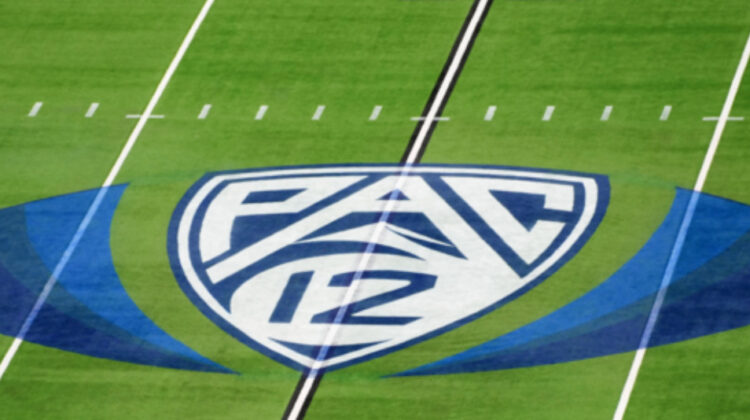There’s an obvious in-house candidate, and it’s not the current commish
The Hotline mailbag publishes each Friday. Send questions to pac12hotline@
bayareanewsgroup.com and include ‘mailbag’ in the subject line. Or hit me on Twitter: @WilnerHotline.Please note: Some questions have been edited for clarity and brevity.
So it seems we may have a two-team conference next year while things play out. If that happens, who is going to be commissioner? Do they even need one? — @brycetacoma
Appreciate the question because it allows us to address two topics at once: Why George Kliavkoff remains commissioner of the Pac-12, and who would lead a ‘Pac-2’ if Washington State and Oregon State compete alone in 2024.
The Hotline has received numerous questions about Kliavkoff’s continued employment after he steered the conference to ruin in early August and lost all credibility with, well, everyone. Our sense: Nobody is motivated to cut him loose.
The two remaining schools aren’t relying on Kliavkoff for strategic advice as they plot their future.
And the 10 outgoing schools don’t need him for strategic advice as they transition into new leagues.
But all 12 schools need someone to oversee the Pac-12’s current competition season and represent the conference on national committees (e.g., the College Football Playoff).
Also, Kliavkoff would be owed $10 million (approximately) if terminated, and nobody wants to pay something for nothing and toss that cash in the trash.
So he remains in place due to inertia, essentially.
What about leadership of the ‘Pac-2’ conference if the Cougars and Beavers compete alone in the 2024-25 sports season?
True, they might not need a league. Everything about their athletic existence would be streamlined, to the point that they potentially could handle operational matters like officiating and cut their own broadcast deals with local television stations.
But if a conference structure is deemed necessary, the obvious candidate is Teresa Gould, the Pac-12’s current deputy commissioner.
Gould has been an athletic director (UC Davis), she worked for a Pac-12 school (Cal), and she understands campus challenges. She’s more than qualified to oversee a scaled-down conference.
Heck, she’s plenty qualified to step in today and run the 12-school league.
That said, it seems unlikely that Gould would be the commissioner of a fully rebuilt Pac-12. Our presumption is that a reconfigured conference with several or all of the Mountain West schools would feature current MW commissioner Gloria Nevarez as the top executive.
And Nevarez knows the Pac-12 well, having served as an executive under former commissioner Larry Scott.
Put another way: Whatever form the conference takes starting next summer, there are two good leadership options.
Who is more culpable in the Pac-12’s demise, former commissioner Larry Scott or current commissioner George Kliavkoff? — @NILvsNLI
It’s only natural to assign blame for the collapse of a 108-year-old college sports institution.
Unfortunately, that’s a complicated endeavor. The demise spanned a dozen years. Many people were complicit.
The morning after five schools departed, the Hotline outlined the 12 strategic mistakes that led to the implosion. And last week, we explained how each departing school’s fingerprints are on the corpse.
Scott and Kliavkoff are certainly culpable, although not nearly to the same extent as the university presidents who ran the conference and produced an astounding mix of indifference, ignorance and incompetence.
They deserve the majority of the blame and, in our humble opinion, that’s beyond dispute.
Scott took the keys to the car, put pedal to the metal and headed for the cliff.
Kliavkoff took over with a quarter mile to go and finished the job, failing to take advantage of several off-ramps in that crucial final stretch.
Both made one wrong move after another.
What’s truly remarkable is the presidents, upon cutting Scott loose in the winter of 2021, ignored the warning signs and hired a replacement who was equally unqualified.
They needed someone who understood college athletics, possessed deep industry contacts and recognized the value of relationships. In Kliavkoff, they went 0-of-3.
So we would offer the following breakdown of blame:
Presidents: 51%
Kliavkoff: 25%
Scott: 24%What happened to the $40 million emergency fund, and who authorized tapping it? — @scottsdaleazwsu
The presidents control the emergency reserves (and all financial assets) and must authorize the use of the funds.
At the end of the 2022 fiscal year, the Pac-12 had $42.7 million in net assets. The reserves were part of that sum, but we don’t know the percentage.
What we do know, according to multiple sources, is that the presidents approved the use of reserves to offset the revenue lost in the Comcast overpayment debacle. As a result, the emergency cash has been exhausted.
With the news about Kliavkoff removing USC and UCLA from the Pac-12 board, what do you expect from the lawsuit Washington State and Oregon State filed against the conference? — @ryan_silva88
Some readers might be unfamiliar, so allow us to summarize the latest development:
While plowing through court records in a lawsuit related to the Comcast overpayment scandal, the Hotline discovered that Kliavkoff, under penalty of perjury, stated in July that the Los Angeles schools had been removed from the Pac-12’s board of directors.
The revelation is potentially significant in the lawsuit filed by Oregon State and Washington State over control of the board.
Why? Because it establishes precedent.
OSU and WSU believe the makeup of the board should not change based on the number of schools that have announced their departures:
If USC and UCLA were removed after announcing they were headed to the Big Ten, as Kliavkoff’s court declaration indicates, the other eight schools should be removed following their announcements, as well.
As for the outcome of the lawsuit, we continue to believe a settlement is the most likely endgame — especially given that the two sides have entered mediation.
However, it’s clear to us that the 10 outgoing schools are attempting to slow the legal process.
Time is essential for WSU and OSU, which must make plans for the 2024 season. (Atop their priority list: a 12-game football schedule.)
A trial would take months. By dragging out the litigation, the defendants seemingly hope to force the plaintiffs to settle.
If Washington State and Oregon State were to rebuild the Pac-12, are there enough schools they can add that will make it Power Five worthy? — @CelestialMosh
Doubtful.
The Power Five designation is controlled by the College Football Playoff. We don’t foresee an outcome in which whatever conference houses the Beavers and Cougars — whether it’s a ‘Pac-2’ or ‘Pac-8’ or fully rebuilt Pac-12 — maintains that categorization.
The Big Ten, SEC and Big 12 would object, and that would be enough to strip the league of the coveted designation.
But don’t forget: The CFP will carve out an automatic bid for the top-ranked school outside the Power Four. Whichever team wins the reconfigured league would have a terrific chance to claim a spot.
Here’s a scenario: Team A has no losses, Team B has one loss and Team C has two losses. Then Team A beats Team B in the championship game. Does Team B get the automatic bid to the New Year’s Six when Team A gets into the playoff? — @RockDawg3
Based on precedent, we would expect Team B to hold its ground in the CFP rankings and thus receive a berth in the New Year’s Six.
The selection committee usually does not punish the loser of conference championship games.
That said, there have been exceptions based on blowout losses and head-to-head results.
For instance, in 2016, Colorado lost the Pac-12 title game to Washington and lost its New Year’s Six spot in favor of USC, but the move was easily justified because the Trojans beat CU during the regular season.
Last year, USC lost to Utah in the title game but received a Cotton Bowl bid anyhow.
If Washington State and Oregon State win the lawsuit with the other 10 schools and ultimately are found to be the rightful owners of all Pac-12 assets, will they also be the only two schools involved in the overpayment lawsuit with Comcast? @Marc_The_Duck
Comcast is withholding $72 million in payments to the Pac-12 in order to make itself whole. That amount is rooted in two buckets:
— Distributions withheld by Comcast to offset 10 years of overpayments (2013-22) based on the company’s flawed tracking of Pac-12 Networks subscribers. That total is $58 million.
— Reductions in distributions in the 2023-24 fiscal years to account for a correction in the subscriber figures. That total is $14 million.
The withholding process is expected to conclude early next year.
As far as we know, the Comcast matter will be settled before the conference breaks apart next summer. WSU and OSU would have no liability if they choose to reconstruct the league.
Texas Tech vs. Baylor and TCU vs. Iowa State both drew less than 500,000 viewers last Saturday. Are they telling us Oregon State and Washington State can’t consistently beat that number? — @MeyersMustache
The realignment game leans heavily into the word’s root: alignment.
Washington State’s viewership numbers in the CFP era are better than those of any Pac-12 school headed into the Big 12 and many of the existing Big 12 schools.
But alignment includes geography, as well. Neither Corvallis nor Pullman are ideally suited for life in the Big 12 — certainly not to the extent of the Four Corners universities, which border the Big 12 footprint.
Iowa State and Texas Tech have the advantage of already being in the Big 12. Their audience numbers don’t matter. Their bona fides are not being judged.
Granted, the Pac-12 schools headed to the Big Ten and ACC aren’t well suited geographically for their new leagues, but they bring something compelling — whether it is their football brand, their media market, or, in the case of the Bay Area schools, their academic reputations.
WSU and OSU don’t have a single, compelling aspect to create the necessary alignment.
Whenever the ACC starts to dissolve, which four schools are most likely to join the Big 12? — Jim Skinner
That outcome is inevitable, but it’s a topic for another column.
Fortunately, we included the ACC’s future in our look at the future of college football. Published 13 months ago, it remains relevant today.
Related posts:
 Pac-12 rewind: Shaw steps down, Dillingham steps in, Williams shines and Washington turns the knife
Pac-12 rewind: Shaw steps down, Dillingham steps in, Williams shines and Washington turns the knife  Pac-12 football: The Hotline’s picks for individual awards and the all-conference teams
Pac-12 football: The Hotline’s picks for individual awards and the all-conference teams 
(AP Photo/Ralph Freso, File)
Pac-12 media rights strategy: The market has spoken; time to cut a deal Pac-12 media rights: Kliavkoff has made no secret about his strategy (and interest in streaming companies)
Pac-12 media rights: Kliavkoff has made no secret about his strategy (and interest in streaming companies)
